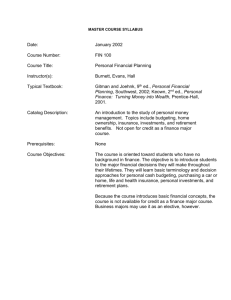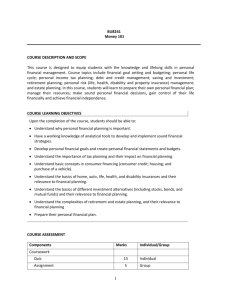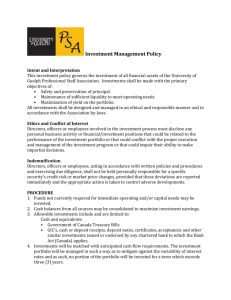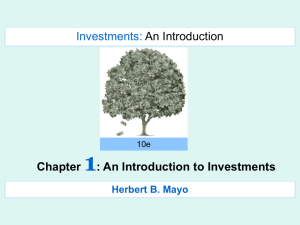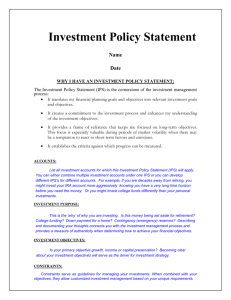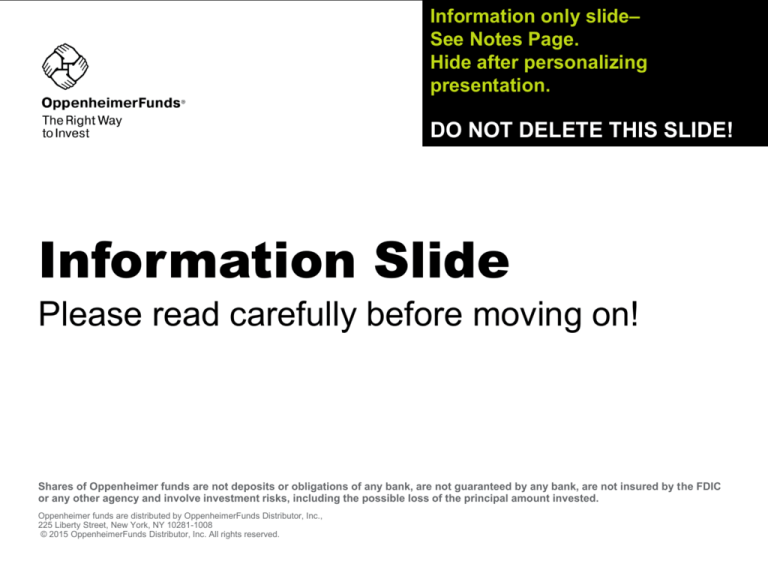
Information only slide–
See Notes Page.
Hide after personalizing
presentation.
DO NOT DELETE THIS SLIDE!
Information Slide
Please read carefully before moving on!
Shares of Oppenheimer funds are not deposits or obligations of any bank, are not guaranteed by any bank, are not insured by the FDIC
or any other agency and involve investment risks, including the possible loss of the principal amount invested.
Oppenheimer funds are distributed by OppenheimerFunds Distributor, Inc.,
225 Liberty Street, New York, NY 10281-1008
© 2015 OppenheimerFunds Distributor, Inc. All rights reserved.
403(b): Saving
for Retirement
Retirement Plan - Enrollment Presentation
Shares of Oppenheimer funds are not deposits or obligations of any bank, are not guaranteed by any bank, are not insured by the FDIC
or any other agency and involve investment risks, including the possible loss of the principal amount invested.
Oppenheimer funds are distributed by OppenheimerFunds Distributor, Inc.,
225 Liberty Street, New York, NY 10281-1008
© 2015 OppenheimerFunds Distributor, Inc. All rights reserved.
403(b): Saving
for Retirement
Retirement Plan - Enrollment Presentation
The person giving this presentation is not employed by, acting on behalf of, affiliated with, nor an agent for, OppenheimerFunds, Inc. or
any of its affiliates.
Shares of Oppenheimer funds are not deposits or obligations of any bank, are not guaranteed by any bank, are not insured by the FDIC
or any other agency and involve investment risks, including the possible loss of the principal amount invested.
Oppenheimer funds are distributed by OppenheimerFunds Distributor, Inc.,
225 Liberty Street, New York, NY 10281-1008
© 2015 OppenheimerFunds Distributor, Inc. All rights reserved.
Your Support Network
Employer
Financial Advisor
OppenheimerFunds
4
Agenda
What retirement is and how much it will cost
Reaching your retirement goal
Investment vehicles and asset categories
Building your portfolio
Getting started
5
What Is Retirement?
Ideally, the ability to achieve financial independence once you stop working
6
What Will Retirement Cost?
Many experts generally agree you will probably need 80% or more of your
preretirement income for each year in retirement.
Preretirement Income
x 80%
x Years in Retirement
Your Total
$40,000
$32,000
x 20
= $640,000
75,000
60,000
x 20
= $1,200,000
7
Where Does Retirement Income Come From?
Social Security
Personal Savings
Retirement Plan
Working Longer
8
Social Security is facing challenges that
include:
Continued cost of living increases
Aging of the population
Reduction in the workforce
Increasing life expectancy
Conditions in the economy
While Social Security provides income for retirement, it should
not be counted on as the only savings for retirement. Employees
need to take charge of their personal retirement savings.
9
What You Could Expect Today
$40,000 – Salary
$75,000 – Salary
Social
Security
29%
Social
Security
35%
Other
65%
$32,000
x 35%
$11,200
Other
71%
(Hypothetical Annual
Total Needed in Retirement)
(Social Security Provides)
(From Social Security)
Source of data: Social Security Administration Benefits Calculator, 2012.
$60,000
x 29%
$17,400
(Hypothetical Annual
Total Needed in Retirement)
(Social Security Provides)
(From Social Security)
10
What Is the Deficit?
$40,000 Salary at Retirement
$32,000
x 35%
$20,800
Total Annual Needed for Retirement
Social Security
Deficit*
$75,000 Salary at Retirement
$60,000
17,400
$42,600
* Unadjusted for inflation
Total Annual Needed for Retirement
Social Security
Deficit*
11
National Averages
The Effects of Inflation
Projected cost in 20 Years
Projected Cost in 20 Years
Item Purchased Today
(3.5% Average
Annual Inflation Rate)
(2.5% Average
Annual Inflation Rate)
Movie ticket for $8
$15.91
$11.88
Gallon of gas $3.88
7.72
5.77
Airline ticket for $500
995.00
743.00
Sources: 1. Federal Reserve Bank of Minneapolis, Consumer Price Index Calculator, 2011. 2. econlife.com, 2011. 3. National
Association of Airline Carrier Owners, 2011.
12
How Will You Close the Gap?
Personal savings
• Great idea but requires discipline to acquire an adequate sum
• May not be tax efficient
Working longer
• Not really retirement, is it?
13
Your Retirement Plan
Pretax Savings
Roth Savings
Tax Deferral
Compounding
14
Pretax Savings
Your taxable pay is reduced and so is your tax
Without a Retirement Plan
$1,000
250
$750
Paycheck
With a Retirement Plan
$1,000
Federal Income Tax
Net Pay
50
Paycheck
Pretax deferral
$950
Taxable now
$238
Federal Income Tax*
$712
Net pay*
*You save $50 on a tax-deferred basis with only a $38 difference
in your paycheck.
This chart is for illustrative purposes and assumes a federal income tax bracket of 25%.
15
Tax-deferred vs. Taxable Investing
Salary:
Savings Goal:
Contribution:
Required Return on
Hypothetical
Investment:
$40,000
$416,000
$250 monthly
$500,000
Tax-deferred result:
$497,872
$450,000
$400,000
6% annually
for 40 years
$350,000
Taxable (25%) result:
$373,404
$300,000
$250,000
$200,000
$0
45
55
65
Age
This chart assumes initial investment at age 25 with a monthly contribution of $250 made on the first of every month for 40 years, and assumes
a 6% hypothetical average rate of return with dividends and distributions reinvested. Withdrawals prior to age 59½ are subject to tax penalties.
The hypothetical ending values may be subject to income tax when withdrawn. This hypothetical example is not intended to show the
performance of any particular investment for any period of time, or fluctuation in principal value or investment returns. The regular investment of
money does not guarantee a profit or protect against losses in declining markets. The chart is for illustrative purposes only.
16
Compounding: Price of Procrastination
Eve, the early investor, comes out ahead in 40 years.
Eve
Early Investor
Paul
Late Investor
Saves $300 a
month starting
at age 25. Stops
saving after 10
years. Total
investment
of just $36,000.
Saves $300 a
month for 30
years starting at
age 35. Total
investment of
$108,000.
Paul
$301,354
by the age
of 65
$350,000
Eve
$306,089 by
the age of 65
$300,000
$250,000
$200,000
0
25
35
45
55
65
Age
The persons portrayed in this example are fictional. This material does not constitute a recommendation as to the suitability of any investment for any
person or persons having circumstances similar to those portrayed, and a financial advisor should be consulted. This chart assumes a person starts
contributing $300 a month at age 25 for 10 years while another person, age 35 contributes the same amount for 30 years. Assuming a fixed average
annual rate of return of 6%, on a tax-deferred basis, with dividends and distributions reinvested. Withdrawals prior to age 59½ are subject to tax
penalties. The hypothetical ending values may be subject to income taxes when withdrawn. This hypothetical example is not intended to show the
performance of any particular investment for any period of time, or fluctuation in principal value or investment returns. Periodic investment plans do
not guarantee a profit or protect against losses in declining markets.
17
Roth 403(b) Option
What Is a Roth 403(b)?
Roth 403(b) is a feature offered by your retirement plan that lets you:
• Fund your retirement account with money that’s already been taxed, and
• Withdraw contribution dollars and any investment earnings tax free, when you meet
certain requirements
Instead of getting a tax break now, you get it later, when you take the
money out
You can contribute as much as you want to one or both of the Traditional 403(b)
and Roth 403(b) as long as the combined total doesn’t exceed your plan’s
yearly contribution limit ($17,500 for 2013)
19
Roth 403 (b)’s Major Benefits
Tax-free distribution of earnings
Higher contributions than a Roth IRA allows, with no income restrictions
Extended tax-free growth
20
How Does It Compare?
Roth 403(b)
Traditional 403(b)
Contributions
After-tax dollars
Pretax dollars
Maximum Allowed
Combined total may not exceed plan’s
maximum
Combined total may not exceed plan’s
maximum
Investment Options
Same
Same
Investment Earnings
Accumulate without current taxation
Accumulate without
current taxation
Withdrawals at Retirement
Tax free if account is held for five years
and experienced a qualifying event (age
59½, disability or death)
Taxed as ordinary income once
owner reaches age 59½
Mandatory Distributions
After Age 70½
Yes
Yes
Roth IRA Rollover Available
Yes
Yes
Employer Matching
Contributions
Employer’s option (treated as pretax
money)
Employer’s option (treated as pretax
money)
21
How Does It Compare?
Roth 403(b)
Roth IRA
Contributions
After-tax dollars
After-tax dollars
Maximum Allowed
Same as Traditional 403(b); applies to
combined Roth 403(b) and Traditional
403(b) contributions
$5,000 + $1,000 catch-up if over age
50 (2012)
Investment Earnings
Accumulate without current taxation
Accumulate without current taxation
Withdrawals at Retirement
Tax free if the investor held the account for
five or more years and experienced a
qualifying event (age 59½, death or
disability)
Tax free if the investor held the account
for five or more years and experienced
a qualifying event (age 59 ½, death or
disability, or first home purchase)
Mandatory Distributions
After Age 70½
Yes
No
Income Limits on Eligibility
No
Yes
22
How to Decide What’s Right for You
See Traditional 403(b)
vs. Roth 403(b) in
403(b) Employee Guide
23
Playing Both Sides
If your circumstances or expectations don’t favor one account over the other,
you can always split your contributions between the two
However, more important than which account you choose is how much and how
soon you save for retirement
24
Investments
Investments
Investments can be categorized into three major classes:
• Equities (stocks)
• Fixed Income (bonds)
• Money market (cash)
26
Stocks (Equities)
Represent units of ownership or shares in a company
Proportional stake in the corporation's assets and profits
Dividends
27
Bonds (Fixed Income) Investments
IOUs issued by corporations or governments in exchange for a loan of money
Repay the principal amount of the bond itself at a specified time
No ownership stake in the company
28
Cash
Money Market
Provides income and liquidity while seeking to maintain a constant value by
investing in short-term, high quality debt instruments.
29
Mutual Funds
Pool investors’ money and purchase stocks or bonds
Target a specific investment objective over time
Advantages:
• Diversification
• Professionally managed
30
OppenheimerFunds
The Right Way to Invest
The Oppenheimer Fund first offered to public in 1959
One of the most recognized names in the industry
A broad range of mutual funds, covering the risk / reward spectrum
Long-standing relationships with financial advisors and financial planners
nationwide
31
A Range of Funds Designed for Every Investor
Global/International Equity
Small-/Mid-cap Equity
Large-cap Growth
Large-cap Value
High Yield Fixed Income
Aggregate Fixed Income
Cash
Investments in global markets involve special risks including currency exchanges, political uncertainties, and are also subject to additional
expenses. Conservative funds generally carry a lower level of risk but also generally offer lower rates of return. Aggressive funds
generally carry a higher level of risk but have the potential to offer a higher rate of return.
32
Cash
Seeks to provide income and liquidity while seeking to maintain a constant value
by investing in short-term, high quality debt instruments. Includes money market
investments that are short-term, low risk securities, such as certificates of
deposits and U.S. Treasury notes.
Special Risks: These types of funds are not insured or guaranteed by the Federal
Deposit Insurance Corporation or any other government agency.
Global/International Equity
Small-/Mid-cap Equity
Large-cap Growth
Large-cap Value
High Yield Fixed Income
Aggregate Fixed Income
Cash
Conservative funds generally carry a lower level of risk but also offer lower rates of return. Aggressive funds generally carry a higher level
of risk but have the potential to offer a higher rate of return. Investments in global markets involve special risks including currency
exchanges, political uncertainties and are also subject to additional expenses.
33
Cash
Aggregate Fixed Income
Seeks to provide current income by investing in a diversified portfolio of U.S.
Government, foreign and corporate bonds.
Special Risks: Fixed income investing entails credit risks and interest rate risks. When
interest rates rise, bond prices generally fall and a fund’s share prices can fall. Foreign
investments may be volatile and involve additional expense and special risks, including
currency fluctuations, foreign taxes and political and economical uncertainties
Global/International Equity
Small-/Mid-cap Equity
Large-cap Growth
Large-cap Value
High Yield Fixed Income
Aggregate Fixed Income
Cash
Conservative funds generally carry a lower level of risk but also offer lower rates of return. Aggressive funds generally carry a higher level
of risk but have the potential to offer a higher rate of return. Investments in global markets involve special risks including currency
exchanges, political uncertainties and are also subject to additional expenses.
35
Aggregate Fixed Income
High Yield Fixed Income
Seeks to provide current income by investing in a diversified portfolio of lower
rated, higher yielding corporate bonds (sometimes called junk bonds).
Special Risks: Fixed income investing entails credit risks and interest rate risks. When
interest rates rise, bond prices generally fall and a fund’s share prices can fall. Belowinvestment-grade (“high yield” or “junk” are more at risk of default and are subject to
liquidity risk.
Global/International Equity
Small-/Mid-cap Equity
Large-cap Growth
Large-cap Value
High Yield Fixed Income
Aggregate Fixed Income
Cash
Conservative funds generally carry a lower level of risk but also offer lower rates of return. Aggressive funds generally carry a higher
level of risk but have the potential to offer a higher rate of return. Investments in global markets involve special risks including currency
exchanges, political uncertainties and are also subject to additional expenses.
37
High Yield Fixed Income
Large-cap Value
Focuses on large-company stocks which the fund manager judges to be
“bargains”—that is, out of favor at the moment or priced lower than they’re worth.
Special Risks: Value investing involves the risk that undervalued securities may not
appreciate as anticipated.
Global/International Equity
Small-/Mid-cap Equity
Large-cap Growth
Large-cap Value
High Yield Fixed Income
Aggregate Fixed Income
Cash
Conservative funds generally carry a lower level of risk but also offer lower rates of return. Aggressive funds generally carry a higher level
of risk but have the potential to offer a higher rate of return. Investments in the global markets involve special risks including currency
exchanges, political uncertainties and are also subject to additional expenses.
39
Large-cap Value
Large-cap Growth
Invests in the common stocks of large, well established companies selected for
potential earnings growth over time.
Special Risks: Investments in securities of growth companies may be especially volatile.
Global/International Equity
Small-/Mid-cap Equity
Large-cap Growth
Large-cap Value
High Yield Fixed Income
Aggregate Fixed Income
Cash
Conservative funds generally carry a lower level of risk but also offer lower rates of return. Aggressive funds generally carry a higher level
of risk but have the potential to offer a higher rate of return. Investments in the global markets involve special risks including currency
exchanges, political uncertainties and are also subject to additional expenses.
41
Large-cap Growth
Small-/Mid-cap Equity
Seeks capital appreciation by investing in the stocks of small and mid-sized
companies with good growth prospects.
Special Risks: Small-and mid-sized company stock in typically more volatile than that of
larger, more established businesses, as these stocks tend to be more sensitive to
changes in earnings expectations and tend to have lower trading volumes than large-cap
securities, creating potential for more erratic price movements. It may take a substantial
period of time to realize a gain on an investment in a small- or mid-sized company, if any
gain is realized at all.
Global/International Equity
Small-/Mid-cap Equity
Large-cap Growth
Large-cap Value
High Yield Fixed Income
Aggregate Fixed Income
Cash
Conservative funds generally carry a lower level of risk but also offer lower rates of return. Aggressive funds generally carry a higher level of risk but
have the potential to offer a higher rate of return. Investments in the global markets involve special risks including currency exchanges, political
uncertainties and are also subject to additional expenses.
43
Small-/Mid-cap Equity
Global/International Equity
Seeks to take advantage of opportunities outside of the United States by
investing in the common stocks of foreign companies.
Special Risks: Foreign investments may be volatile and involve additional expenses
and special risks, including currency exchanges, accounting differences, differences in
securities regulations, political and economic uncertainties. Emerging and developing
market investments may be especially volatile.
Global/International Equity
Small-/Mid-cap Equity
Large-cap Growth
Large-cap Value
High Yield Fixed Income
Aggregate Fixed Income
Cash
Conservative funds generally carry a lower level of risk but also offer lower rates of return. Aggressive funds generally carry a higher level
of risk but have the potential to offer a higher rate of return. Investments in global markets involve special risks including currency
exchanges, political uncertainties and are also subject to additional expenses.
45
Global/International Equity
Other Funds
Dealing with Risk
You can't avoid risk but you CAN manage it. How?
Diversify (mutual funds)
Dollar cost averaging
Asset allocation
Mutual funds are subject to market risk and volatility. Shares may gain or lose value.
48
Dollar Cost Averaging
Investing equal amounts of money at regular intervals on an ongoing basis
You buy fewer shares when prices are high and more shares when prices
are low
Since dollar cost averaging plans involve continuous investments regardless of price levels of fund shares, you should consider your
financial ability to continue purchases through periods of low price levels. Such plans do not guarantee profit nor protect against losses in
declining markets.
49
Dollar Cost Averaging
Quarter
Regular Investments
Price Per Share
Share Purchased
1
$100
$10
10
2
100
5
20
3
100
10
10
4
100
5
20
Total
$400
60
Average cost per share: $6.67 ($400÷60)
Average price per share: $7.50 ($10+$5+$10+$5 = $30÷4)
Automatic investment plans do not guarantee a profit nor protect against losses in declining markets. Dollar cost averaging involves
continuous investments regardless of price levels of fund shares, and you should consider your financial ability to continue purchases
through periods of low price levels. These charts do not depict the prices or investment performance of any investment.
50
Asset Allocation
Divides your assets among a variety of investment categories
Helps reduce overall portfolio risk by offering a higher degree of diversification
Takes advantage of market cycles
Asset allocation cannot eliminate the risk of fluctuating prices and uncertain returns. Diversification does not guarantee profit or protect
against loss. .
51
Investor Profile
Your Investor Profile
An appropriate investment mix depends on your "profile“ as an investor
Choose investments based on your goals
Find a comfortable level of risk, and
Consider your time horizon
53
Oppenheimer Portfolio Series
Asset Allocation Funds
Oppenheimer Portfolio Series
Fund of funds—diversified among a variety of underlying mutual funds
Premixed portfolios of investments rebalanced by professional investment managers on a
regular basis
Provides a simplified investment selection process based on your financial goals, time
horizon and risk tolerance
Diversification does not guarantee a profit or protect against loss.
Asset allocation cannot eliminate the risk of fluctuating prices and uncertain returns.. A fund’s performance depends largely on the
portfolio manager’s skill in selecting the best mix of investments. The portfolio manager’s evaluations and assumptions regarding the
prospects of the global financial markets may be incorrect and the fund’s performance may be adversely affected by his asset allocation
decisions.
55
Oppenheimer Portfolio Series
Conservative Investor Fund
Moderate Investor Fund
Active Allocation Fund
Equity Investor Fund
56
Product Line – Portfolio Series Target Allocations
(As of June 30, 2012)
Oppenheimer Conservative Investor Fund
10%
10%
21%
10%
U.S. Equity
U.S. Fixed Income
International Equity
International Fixed Income
Alternatives
4%
Oppenheimer Moderate Investor Fund
8%
36%
12%
U.S. Equity
U.S. Fixed Income
International Equity
International Fixed Income
Alternatives
34%
55%
Oppenheimer Active Allocation Fund
Oppenheimer Equity Investor Fund
20%
35%
5%
4%
18%
U.S. Equity
U.S. Fixed Income
International Equity
International Fixed Income
Alternatives
Active Allocation
45%
55%
U.S. Equity
U.S. Fixed Income
18%
Percentages shown are target allocations. The actual asset allocations of Oppenheimer Portfolio Series Funds may vary and are subject
to change in accordance with the prospectus.
57
Benefits
Professional Asset Allocation
• Investment expertise of OppenheimerFunds
A unique structure and investment approach
• Disciplined investment process
• Array of powerful diversifiers
Ease of Use
• Simplified investing with automatic rebalancing
58
Things to Consider
Oppenheimer Portfolio Series
Before Investing, Keep in Mind…
These portfolios may be appropriate for a retirement plan investment, however, they are not a complete investment program. An investment in a
portfolio is not guaranteed and a portfolio can suffer losses, including losses near, at, or after the transition date, and there is no guarantee that a
portfolio will provide adequate income at and through the investor’s retirement. Diversification does not assure a profit or protect against loss.
In managing the portfolios, the manager will have the authority to select and substitute certain underlying Oppenheimer funds, as designated in
the prospectus, and may be subject to potential conflicts of interest because the fees paid to it by some underlying funds are higher than the fees
paid by others. However, the manager is obligated to act in each portfolio’s best interests when selecting underlying funds. Each of the
underlying funds in which the portfolios invest has its own investment risks, and those risks can affect the value of each portfolio’s shares and
investments In addition, there is no guarantee that the underlying funds will achieve their investment objectives. The underlying funds may
change their investment objectives or policies without the approval of the portfolio, and a portfolio may be forced to sell its shares of the
underlying funds at a disadvantageous time.
The Fund's performance depends largely on the portfolio manager's skill in selecting the best mix of investments. The portfolio manager's
evaluations and assumptions regarding the prospects of the global financial markets may be incorrect and the Fund's performance may be
adversely affected by his asset allocation decisions. Foreign investments (especially those in emerging and developing markets) may be volatile
and involve additional expenses and special risks, including currency fluctuations, foreign taxes and political and economic uncertainties.
Investments in securities of technology, growth and small-cap companies may be especially volatile. Value investing involves the risk that
undervalued securities may not appreciate as anticipated. Fixed income investing entails credit risks and interest rate risks. When interest rates
rise, bond prices generally fall, and the Fund's share prices can fall. Below-investment-grade (“high yield” or “junk”) bonds are more at risk of
default and are subject to liquidity risk. Derivative instruments, investments whose values depend on the performance of an underlying security,
asset, interest rate, index or currency, entail potentially higher volatility and risk of loss compared to traditional stock or bond investments.
Because they do not have an active trading market, shares of Real Estate Investment Trusts (REITs) may be illiquid. The lack of an active
trading market may make it difficult to value or sell shares of REITs promptly at an acceptable price. In addition, the owning high concentrations
of energy-related natural resources may significantly influence returns. Inflation-indexed debt securities are bonds structured to seek to provide
protection against inflation. If inflation declines, the principal amount or the interest rate of an inflation-indexed bond will be adjusted downward.
This will result in reduced income and may result in a decline in the bond's price which could cause losses for the Fund. Interest payments on
inflation-protected debt securities can be unpredictable and will vary as the principal or interest rate is adjusted for inflation. Inflation-indexed
debt securities are also subject to the risks associated with investments in fixed income securities.
You can obtain additional information about each portfolio, including its glide path design, by visiting our website at
oppenheimerfunds.com or calling us at 1.800.525.7048. This information also may be available through your plan sponsor.
See the prospectus and, if available, summary prospectus for additional risks of the portfolios and the underlying funds.
59
Getting Started
Plan Provisions
Eligibility
Approved Providers
Contributions
Withdrawals
Loans
Vesting
Statements
61
Getting Started
Account application
Try to turn it in today
Don't forget the due date!
62
Resources
Ongoing Personal Support
Voice Response Unit (VRU)
Statements
Quarterly Newsletter
• Handsignals
64
Next Steps
Enroll today!
Speak with your plan sponsor for more information
Contact your financial advisor
65
Thank You! Questions?
Shares of Oppenheimer funds are not deposits or obligations of any bank, are not guaranteed by any bank, are not insured by the
FDIC or any other agency, and involve investment risks, including the possible loss of the principal amount invested.
Before investing in any of the Oppenheimer funds, investors should carefully consider a fund’s
investment objectives, risks, charges and expenses. Fund prospectuses and summary
prospectuses contain this and other information about the funds, and may be obtained by
asking your financial advisor, visiting oppenheimerfunds.com or calling 1.800.525.7048. Read
prospectuses and summary prospectuses carefully before investing.
This material is provided for general and educational purposes only, and is not intended to provide legal, tax or investment advice, or
for use to avoid penalties that may be imposed under U.S. federal tax laws. Contact your attorney or other advisor regarding your
specific legal, investment or tax situation.
Oppenheimer funds are distributed by OppenheimerFunds Distributor, Inc.
Two World Financial Center, 225 Liberty Street, New York, NY 10281-1008
©Copyright 2010 OppenheimerFunds Distributor, Inc. All rights reserved.
RE0000.366.0912 September 30, 2012
`
66

